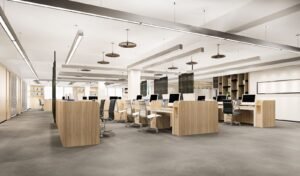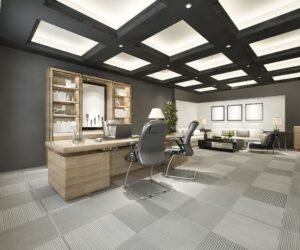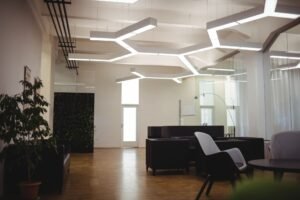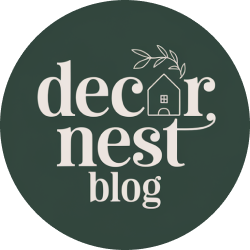Suppose you walk into your office, and the moment you step inside, you feel motivated. The space feels open, welcoming, and perfectly organized. The colors lift your mood, the layout makes moving around easy, and every detail seems to say, “This is where great ideas happen.”
That’s the magic of well-thought-out corporate office interior design ideas paired with thoughtful space planning. A good office isn’t just about professionalism, but also about creating an environment where people feel comfortable, focused, and inspired to do their best work.
Whether you manage a large corporate headquarters or a small office in the heart of the city, design matters. A thoughtfully planned space can improve productivity, make teamwork easier, and leave a strong impression on clients and visitors. When the design feels right, employees enjoy coming to work, and that’s priceless for any business.
For smaller offices, the challenge is making the most out of every inch. This is where office design ideas for small spaces shine. With the right choices, like clever storage solutions, multi-purpose furniture, and innovative layouts, you can create a workspace that feels bigger, brighter, and more efficient.
Your office is more than a place to work. It’s a reflection of your brand, your values, and your company’s personality. The way it looks and functions can set the tone for your entire business. A well-designed office not only supports daily tasks but also makes people feel proud to be there.
If you want your workplace to work harder for you, it’s time to combine style with strategy. With the right design and thoughtful planning, you can create an office that looks amazing, works efficiently, and inspires everyone who walks through the door.
Why Corporate Office Interior Design Matters

When you walk into a corporate office that’s thoughtfully designed, the impact is immediate. The lighting, layout, colors, and furniture all work together to create an environment that not only looks professional but also makes employees feel comfortable, focused, and motivated. That’s why investing in corporate office interior design ideas is more than aesthetics, about creating a workspace that drives results.
Enhancing Productivity Through Design
A well-planned office can significantly enhance productivity. Natural light, ergonomic furniture, and innovative layouts allow employees to work efficiently without feeling cramped or stressed. Spaces that are clutter-free, well-lit, and strategically arranged can reduce distractions, streamline workflow, and even improve mental well-being. Incorporating office design ideas for small spaces ensures that even compact offices feel open, organized, and conducive to high performance. Productivity doesn’t just come from hard work; it comes from the environment supporting that work.
Reflecting Brand Identity in the Workspace
Your office is an extension of your brand. Every detail, from wall colors to furniture style, communicates your company’s personality and values to employees, clients, and visitors. Thoughtful corporate office interior design ideas allow businesses to showcase their culture, whether it’s innovative, professional, creative, or welcoming. This reflection of identity can boost employee pride and make clients feel aligned with your brand.
Key Principles of Corporate Office Interior Design Ideas

Successful office design blends aesthetics and functionality. It’s not just about looking good; it’s about creating spaces that work well for your team.
Balancing Aesthetics and Functionality
Striking the right balance between style and practicality is crucial. Elegant furniture, modern lighting, and attractive finishes should complement the day-to-day needs of employees. Incorporating office design ideas for small spaces with multi-purpose furniture or hidden storage keeps offices looking clean and spacious, while still providing everything employees need to work efficiently.
Incorporating Ergonomics for Employee Comfort
Comfortable workspaces are productive workspaces. Ergonomic chairs, adjustable desks, and proper monitor placement reduce physical strain and fatigue. Even in smaller offices, corporate office interior design ideas can include ergonomic solutions that can significantly improve employee health and long-term satisfaction.
Smart Office Design Ideas for Small Spaces

Small office spaces don’t mean compromising on style or efficiency. With thoughtful planning, limited areas can become functional and inviting.
Multi-Functional Furniture Solutions
Furniture that serves multiple purposes is a game-changer for compact offices. Desks with storage, foldable tables, or modular seating can transform a small room into a versatile workspace. These solutions align perfectly with office design ideas for small spaces, allowing each square foot to be maximized without overcrowding.
Open Layouts to Maximize Floor Space
Open layouts reduce barriers, improve visibility, and make the office feel larger. By avoiding unnecessary partitions, even modest-sized offices can feel airy and spacious. Open layouts encourage collaboration while leaving room for individual focus areas.
Glass Partitions for a Spacious Feel
For offices that need separation without closing off space, glass partitions are ideal. They create private zones while maintaining a sense of openness. This modern approach to corporate office interior design ideas also enhances natural light distribution, making the workspace feel bright and welcoming.
Creative Corporate Office Layout Concepts

A well-thought-out layout encourages teamwork, focus, and relaxation, all of which are essential for a productive office.
Collaborative Zones for Teamwork
Designated collaborative areas, like open tables or shared desks, allow teams to brainstorm freely. Bright, inviting spaces with comfortable seating and flexible arrangements inspire creativity and strengthen teamwork. These zones are an essential part of modern corporate office interior design ideas.
Quiet Pods for Focused Work
Not every task requires collaboration. Quiet pods or private corners provide employees with spaces to focus without distractions. These areas are critical in office design ideas for small spaces, as they allow for concentration in a compact footprint while maintaining overall flow and accessibility.
Breakout Areas for Relaxation and Networking
Breakout areas encourage employees to take meaningful breaks, recharge, and socialize. Comfortable seating, coffee stations, or even small lounge corners foster a positive office culture. Thoughtful corporate office interior design ideas integrate these areas seamlessly, ensuring that even in a small office, employees have spaces to unwind and connect.
By blending productivity, style, and functionality, corporate office interior design ideas can transform any workspace into an environment that energizes employees, impresses clients, and represents your brand identity. With careful planning, even small offices can feel open, professional, and inspiring. Using bright office design ideas for small spaces, companies can achieve layouts that balance collaboration, focus, and comfort, making the workplace more than just a place to work, but a space that motivates and delights everyone who enters.
Lighting and Color Schemes in Corporate Interiors

Lighting and color play a crucial role in shaping the mood, productivity, and overall feel of a corporate office. Properly planned corporate office interior design ideas take these elements seriously to create spaces where employees feel motivated, energized, and comfortable throughout the workday.
Using Natural Light to Improve Mood
Natural light is more than just a design feature; it impacts well-being and performance. Offices that maximize windows or include skylights help employees feel awake and focused. Studies show that natural light can reduce stress, improve mood, and even enhance creativity. For office design ideas for small spaces, using reflective surfaces, glass partitions, and light-colored walls can help distribute daylight evenly across the workspace. Additionally, pairing natural light with adjustable blinds or shades ensures comfort while controlling glare on computer screens.
Color Psychology for Office Productivity
Color influences emotion and productivity, making it a critical part of corporate office interior design ideas. Warm colors like soft yellows or muted oranges can stimulate energy and collaboration in open team areas. Cooler tones, such as blues and greens, promote focus and calm in individual workstations or quiet zones. Neutral palettes like grays, whites, and beiges provide a professional backdrop, which can be accented with brand colors for identity and visual interest. Thoughtful color combinations, whether bold or subtle, help shape the office culture and enhance the overall mood.
Storage and Organization in Limited Spaces
Efficient storage and organization are essential, especially for small offices. Clutter can quickly disrupt workflow, reduce productivity, and make spaces feel cramped. Innovative office design ideas for small spaces focus on maximizing storage without sacrificing aesthetics.
Vertical Storage Solutions
Vertical storage is ideal for compact offices. Tall shelving units, wall-mounted cabinets, and overhead compartments utilize wall space effectively while keeping floors open. Open shelves or glass-front units allow for easy access and display of essentials while maintaining a clean look. Combining vertical storage with decorative elements like plants or framed certificates balances functionality with style. These solutions ensure that every inch of space is optimized without making the office feel crowded.
Built-In Cabinets and Hidden Storage
Built-in cabinets and hidden compartments provide storage for documents, office supplies, and personal items, keeping work areas uncluttered. Custom cabinetry that fits seamlessly into walls or under desks maintains a polished look while maximizing utility. For corporate office interior design ideas, these hidden storage options allow small spaces to feel open and organized, improving efficiency and visual appeal.
Technology Integration for Modern Offices

Modern corporate offices are increasingly leveraging technology to streamline operations, improve comfort, and boost productivity. Integrating tech solutions into corporate office interior design ideas allows businesses to create innovative, efficient, and future-ready workspaces.
Smart Meeting Rooms
Bright meeting rooms equipped with wireless projectors, interactive screens, and video conferencing tools help teams collaborate efficiently. Automated booking systems and room occupancy sensors ensure that meeting spaces are used effectively. Integrating these technologies into office design, including thoughtful lighting and furniture placement, enhances both functionality and aesthetics. For small offices, multi-purpose rooms can combine private meetings, group brainstorming, and virtual collaboration without overcrowding.
Automated Lighting and Climate Control
Automated systems for lighting and climate control improve comfort while conserving energy. Sensors that adjust brightness based on daylight levels or occupancy reduce electricity consumption and enhance employee well-being. Similarly, smart thermostats maintain consistent temperature zones tailored to employee needs. Incorporating these technologies into corporate office interior design ideas allows offices to stay energy-efficient and responsive, providing a modern and comfortable environment for work.
Conclusion
Corporate office interior design goes beyond aesthetics and directly impacts employee productivity, comfort, and the overall success of a business. By thoughtfully planning lighting, color schemes, furniture layout, and storage, companies can create workspaces that are both functional and visually appealing. Intelligent space planning, especially in smaller offices, allows every square foot to be optimized without compromising on style or comfort.
Incorporating technology, such as automated lighting, climate control, and bright meeting rooms, ensures that modern offices stay efficient and adaptable. Combining these elements with carefully selected materials, ergonomic furniture, and design features that reflect the company’s brand identity creates an environment where employees feel motivated and valued.
A well-designed corporate office not only improves day-to-day workflow but also leaves a strong impression on clients and visitors. Whether it’s a small startup or a large corporate headquarters, investing in professional interior design ideas elevates the work experience, encourages collaboration, and fosters innovation.
Ultimately, the key is balancing aesthetics, functionality, and employee well-being. Businesses that pay attention to these aspects of corporate office interior design ideas will enjoy a workspace that inspires productivity, supports growth, and stands out in 2025 and beyond.
Also Read these blogs :-
Creative Home Office Bedroom Combos for Small Homes
Wall Decor Ideas for Office and Remote Workspaces
FAQs
1.What are the latest corporate office interior design ideas for 2025?
The latest trends include open layouts with collaborative zones, quiet pods for focused work, breakout areas for relaxation, bright lighting, ergonomic furniture, natural materials, and the use of brand colors to create a cohesive identity. Multi-functional spaces that adapt to different tasks are also very popular.
2.How can I make a small corporate office look more spacious?
Maximize natural light, use light-colored walls, and incorporate glass partitions to create a sense of openness. Vertical storage, built-in cabinets, and minimal furniture reduce clutter. Open layouts and multi-purpose furniture can also help small offices feel more roomy and efficient.
3.What colors work best for a productive office environment?
Blue and green tones promote focus and calm, while warm colors like soft yellows or muted oranges can stimulate creativity and collaboration. Neutral palettes like white, beige, or gray provide a professional backdrop and pair well with accent colors for brand identity or energy.
4.How does thoughtful space planning improve workplace efficiency?
Thoughtful space planning ensures that every area of the office is functional and purposeful. It reduces wasted space, enhances workflow, supports ergonomic design, and encourages collaboration. Well-planned office layouts help employees move seamlessly between tasks and prevent congestion in busy areas.
5.What furniture is ideal for small corporate office spaces?
Choose multi-functional furniture such as foldable desks, modular seating, built-in storage, and compact workstations. Ergonomic chairs and adjustable desks improve comfort, while modular or movable furniture allows flexibility for meetings or workspace reconfiguration.
6.How can I incorporate technology into modern office interiors?
Integrate bright lighting and climate control, automated meeting room setups, video conferencing systems, and interactive screens. Cable management systems, hidden power outlets, and IoT-enabled devices create a clean, efficient, and tech-friendly environment.
7.What is the average cost of corporate office interior design?
Costs vary depending on office size, materials, and design complexity. On average, small to medium-sized offices in the US may spend $50–$150 per square foot for professional interior design services, including furniture, lighting, and technology integration. Large corporate offices can see higher costs, particularly for custom features and high-end finishes.
